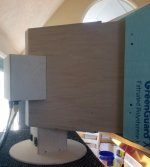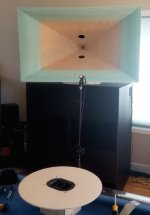Thanks Bill, and thankyou for your spreadsheet. It has made building my synergy test box so much easier

I was also wondering if 50° angle isn't to shallow.
If you array them it seems logical but as a single speaker wouldn't it be better to do 90*60? The bill waslo design used 90*60. I really like his spreadsheet.
I was thinking to go for 80*60 and the lowest frequency for pattern control would be 370Hz going lower would make the speaker a little bit to big.
Pattern is such a tough call. I've tried 60x60, 60x40, and now 90x60.
I can't really give a decent apples to apples comparison just due to pattern, because they each reached different stages of development.
Although the 60x40 and 90x60 may be a close to fair comparison, in that their mouth sizes are about the same...46 and 48" wide.
I prefer the 60x40 a wee bit.
But that said, with waveguides on CDs used down to 650Hz, I know i like 60x40 better than 90x60...so the prefence is probably just me ...
Fwiw, the well regarded k-402 appears to have about a 77x47 straight sided conical flare for the first 2/3 of the way towards the mouth, before turning tractrix-like for the last 1/3.
If i were building another synergy from scratch, i think i'd try that or something in the (80-75) x (50-45) camp....just to split the difference between 90 and 60 degree horiz.
Oh ditto what Bill said about port location over driver. Center location goes higher, but as we know makes distance to throat difficult.
I have gone for 80 X 60 angles just to be something in between 60x40 and 90x60.
60x40 is sometimes to narrow to get a decent coverage. Especially cause I want to use them in the garden. And 90x60 is sometimes to much.
As an added benefit using the spreadsheet I calculated that using 80x60 I could get down to 370Hz for the lowest pattern control which is good.
The depth is also good enough that I can fit mid/bass drivers the size of 12" if needed. Altough that 12" might be pushing things a little.
Haven't decided on those yet.
The beyma 8" 8P300 doesn't look to bad with decent Xmax en power.
4 of those can really do some things. I have used them before and they really deliver for such a small speaker.
Altough I like the impact and slam of a good 12" a lot more.
The Beyma 12p80Ndv2 is a great driver. sounds very clean with a lot of punch.
Qts of only 0.19 and works well in small cabinets.
Even when used front loaded it has the impact and tightness like many great midbass horns.
2 of those will probably be enough with a sensitivity of 100db /w /m, maybe just a little bit too much.....
60x40 is sometimes to narrow to get a decent coverage. Especially cause I want to use them in the garden. And 90x60 is sometimes to much.
As an added benefit using the spreadsheet I calculated that using 80x60 I could get down to 370Hz for the lowest pattern control which is good.
The depth is also good enough that I can fit mid/bass drivers the size of 12" if needed. Altough that 12" might be pushing things a little.
Haven't decided on those yet.
The beyma 8" 8P300 doesn't look to bad with decent Xmax en power.
4 of those can really do some things. I have used them before and they really deliver for such a small speaker.
Altough I like the impact and slam of a good 12" a lot more.
The Beyma 12p80Ndv2 is a great driver. sounds very clean with a lot of punch.
Qts of only 0.19 and works well in small cabinets.
Even when used front loaded it has the impact and tightness like many great midbass horns.
2 of those will probably be enough with a sensitivity of 100db /w /m, maybe just a little bit too much.....
I look forward to seeing how your build progresses. Sounds like you have a good handle on the trade-offs.
How much weight are you willing to accept?
Weight has dominated my current syn in progress.
I've used two 10" faital 10FE200's located on top and bottom of horn per below pict. Made for a real lightweight design.
But even with the port out in the middle of the cone, away from the throat, it still took a 90 degree horizontal spread to get them to fit on the top and bottom. Otherwise i would have gone with 75-80 degrees.
I've been spending weeks trying to develop a foam board secondary flare.
I'm far enough along I've stopped refining the flare for now, and am working on learning how to use epoxy and glass cloth, to strengthen them.
Flares will be detachable for easy transport and storage, with horiz control to just under 200Hz.
Total weight including flares should be about 48lbs.
Stand/base even has an adjustable-tilt pole mount in it .🙂
How much weight are you willing to accept?
Weight has dominated my current syn in progress.
I've used two 10" faital 10FE200's located on top and bottom of horn per below pict. Made for a real lightweight design.
But even with the port out in the middle of the cone, away from the throat, it still took a 90 degree horizontal spread to get them to fit on the top and bottom. Otherwise i would have gone with 75-80 degrees.
I've been spending weeks trying to develop a foam board secondary flare.
I'm far enough along I've stopped refining the flare for now, and am working on learning how to use epoxy and glass cloth, to strengthen them.
Flares will be detachable for easy transport and storage, with horiz control to just under 200Hz.
Total weight including flares should be about 48lbs.
Stand/base even has an adjustable-tilt pole mount in it .🙂
Attachments
Nice build.
I am getting forward with the build. pictures will come in a few days (I hope).
Simulation predicts the first notch at around 1k2. This is the goal I am after.
Playing with the hole diamter of the midranges I can let it rollof further.
Maybe it would be possible to only use a HP filter on the mid section.
Makes the crossover (and phase) more easy.
Simulating the compression driver is something I don't know how to do in Hornresp.
I've seen some examples but I can"t get it to work.
For the lower section I'm still looking around for a great mid-bass.
-12" would be nice but mounting them is difficult.
-would be nice to keep it 8ohm in impedance so I would need 4 drivers or the drivers would need to be 4 or 16ohm when using only 2 drivers.
The beyma 8p300Fe/N still looks good and will go quite low. I've heard them before and they really deliver.
However4 of them around 100€ each is getting a little bit much.
Then I've looked at the oberton 8MB201. A little bit more Xmax and Qms is a little bit lower.
The 8MB201 is a bass/mid speaker as the 8p300Fe/N is more of a real Bass speaker.
8MB201 will not go as low but I think it would be a better fit for this application.
It will probably have more punch/slam. EBP is higher also
And it is a little bit cheaper. I could get them for around 67€.
For the crossover I will first measure impedance and Frequency response and I discovered Xsim wich really makes life a lot easier.
When I have some pictures and frequency plots I will give an update
Another thing. When I was talking with my dad about this speaker. He came with the idea to make a mould of the horn so I could make some horns in glassfibre/epoxy... could be an idea indeed.
I am getting forward with the build. pictures will come in a few days (I hope).
Simulation predicts the first notch at around 1k2. This is the goal I am after.
Playing with the hole diamter of the midranges I can let it rollof further.
Maybe it would be possible to only use a HP filter on the mid section.
Makes the crossover (and phase) more easy.
Simulating the compression driver is something I don't know how to do in Hornresp.
I've seen some examples but I can"t get it to work.
For the lower section I'm still looking around for a great mid-bass.
-12" would be nice but mounting them is difficult.
-would be nice to keep it 8ohm in impedance so I would need 4 drivers or the drivers would need to be 4 or 16ohm when using only 2 drivers.
The beyma 8p300Fe/N still looks good and will go quite low. I've heard them before and they really deliver.
However4 of them around 100€ each is getting a little bit much.
Then I've looked at the oberton 8MB201. A little bit more Xmax and Qms is a little bit lower.
The 8MB201 is a bass/mid speaker as the 8p300Fe/N is more of a real Bass speaker.
8MB201 will not go as low but I think it would be a better fit for this application.
It will probably have more punch/slam. EBP is higher also
And it is a little bit cheaper. I could get them for around 67€.
For the crossover I will first measure impedance and Frequency response and I discovered Xsim wich really makes life a lot easier.
When I have some pictures and frequency plots I will give an update
Another thing. When I was talking with my dad about this speaker. He came with the idea to make a mould of the horn so I could make some horns in glassfibre/epoxy... could be an idea indeed.
Ok the glue has dried and I did a first test.
It's a very rough test just to have a first idea. In a few days my measurement setup will be much better.
I used the DATS interface which has a small amplifier but there is a resistance also as it is normally used for impedance measurements ...
But for a first test this was easy to setup.
Microphone is calibrated but the distance was relatively close inside a room.
But the result can give a first impression I think.
This are the midranges
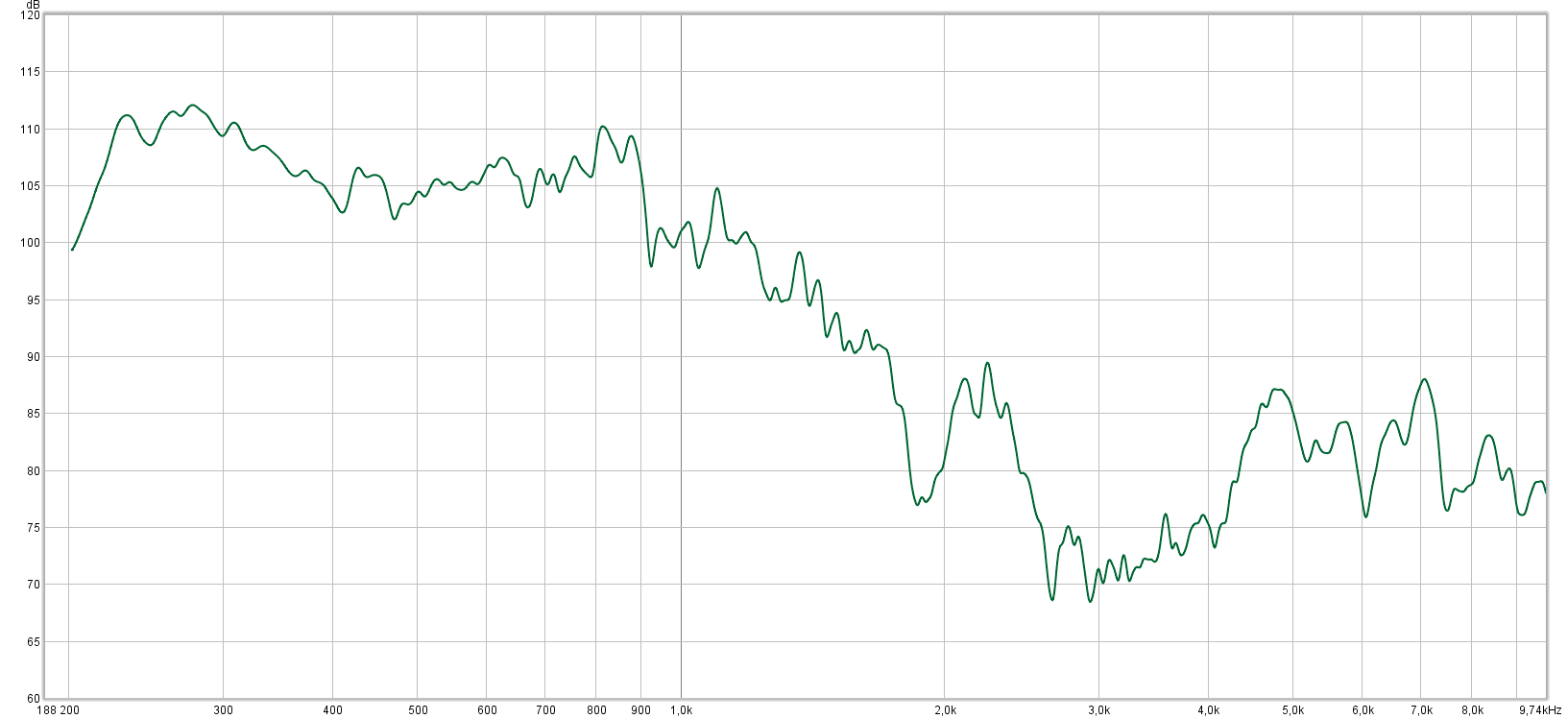
It looks like it goes quite low. Altough The hump in the low could be because of the resistance in the DATS interface amplifier.
Then it goes quite good untill around 900Hz it suddenly drops whereafter it drops more slowly.
Around 1k9 there is a notch.
I'm wondering if that drop at 900Hz could be the first cancellation notch.
If so that could be a problem.
The mounting piece for the tweeter is 12mm in thickness so maybe I could reduce this if needed using a metal piece instead of wood?
I'm gonna do some better measurements outside when I have the chance with a better setup.
Then I also did a measurement for the compression driver
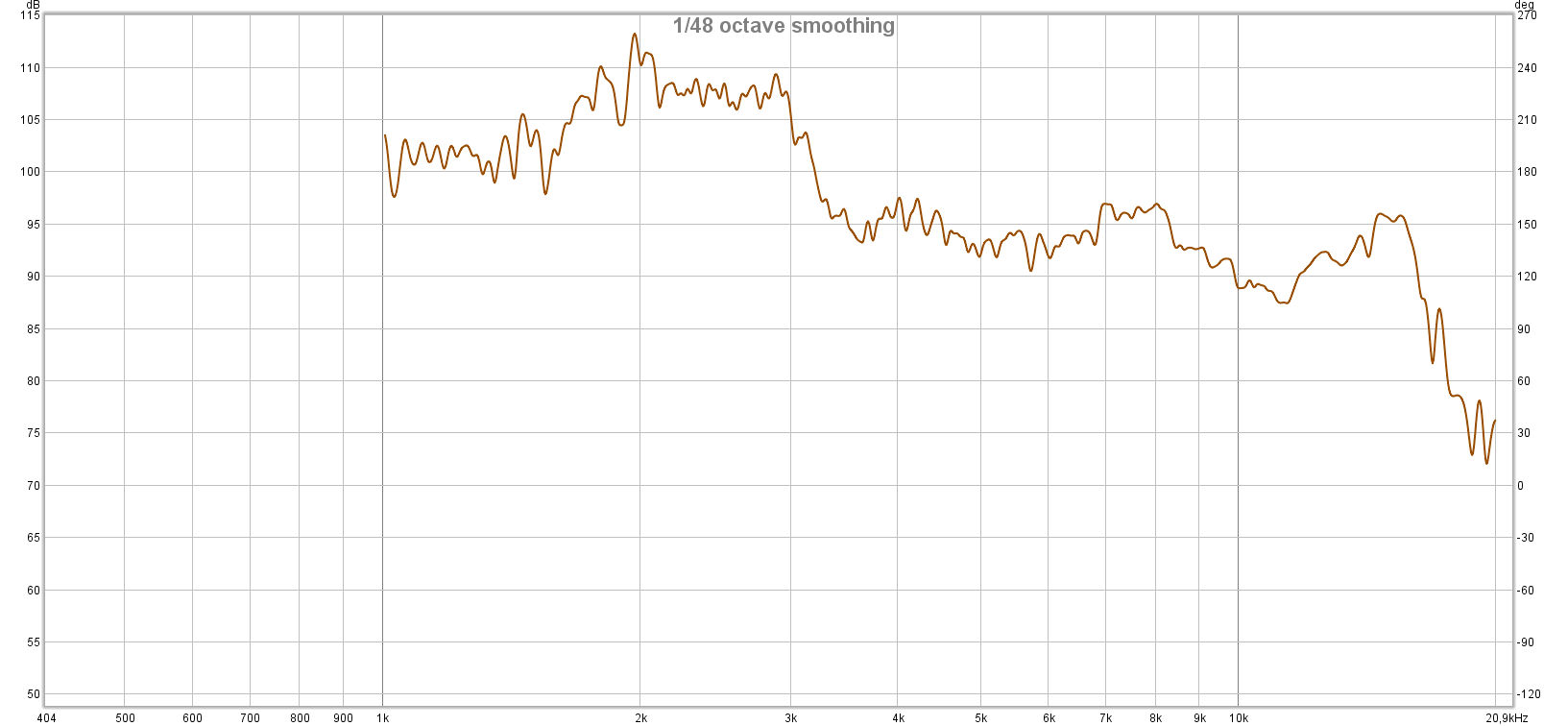
There is quite a big hump between around 1k8 and 3k.
Don't know why this is. I still have to check everything for leaks so there could also be a problem.
And yet again a better setup with a decent amplifier could also make a difference.
more to come
It's a very rough test just to have a first idea. In a few days my measurement setup will be much better.
I used the DATS interface which has a small amplifier but there is a resistance also as it is normally used for impedance measurements ...
But for a first test this was easy to setup.
Microphone is calibrated but the distance was relatively close inside a room.
But the result can give a first impression I think.
This are the midranges

It looks like it goes quite low. Altough The hump in the low could be because of the resistance in the DATS interface amplifier.
Then it goes quite good untill around 900Hz it suddenly drops whereafter it drops more slowly.
Around 1k9 there is a notch.
I'm wondering if that drop at 900Hz could be the first cancellation notch.
If so that could be a problem.
The mounting piece for the tweeter is 12mm in thickness so maybe I could reduce this if needed using a metal piece instead of wood?
I'm gonna do some better measurements outside when I have the chance with a better setup.
Then I also did a measurement for the compression driver

There is quite a big hump between around 1k8 and 3k.
Don't know why this is. I still have to check everything for leaks so there could also be a problem.
And yet again a better setup with a decent amplifier could also make a difference.
more to come
Last edited:
So today I fixed a few small leaks.
I also used a decent amplifier to do some measurements.
The midhorn looks a lot better I think.:
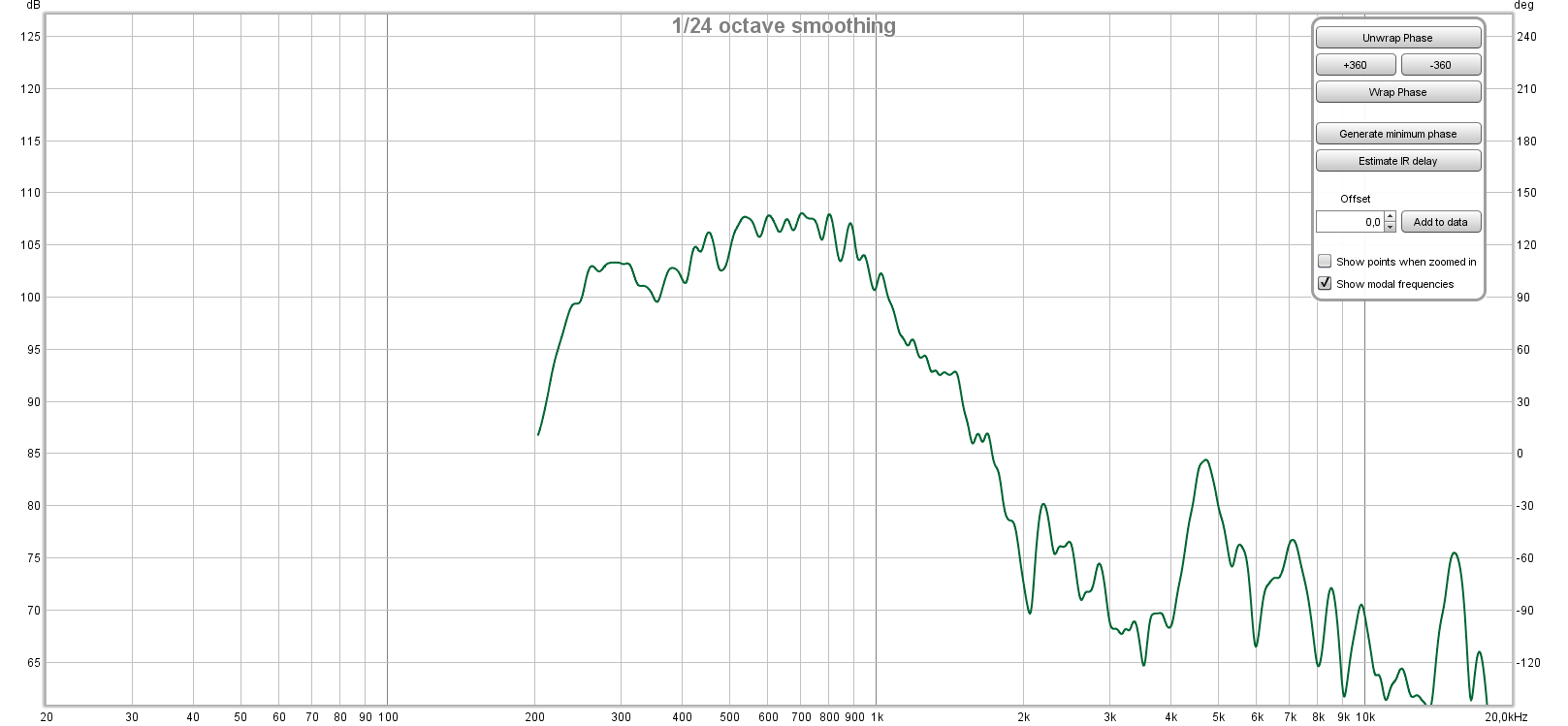
The compression driver is also better:
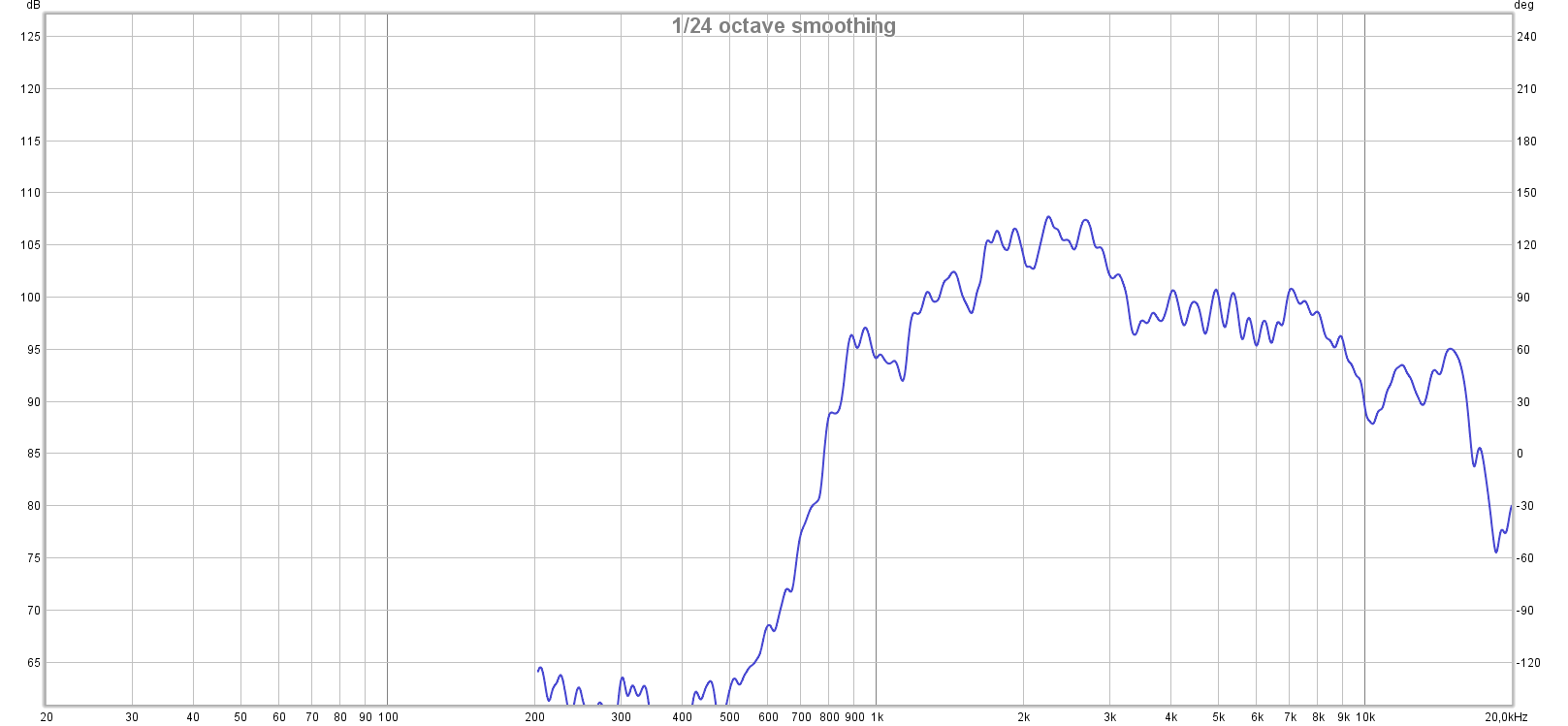
So after a little bit of trying with an active crossover I've put the compression driver on High Pass 1k2 L/R 4th order.
The mid section was High passed at around 350Hz. they did go lower but I think the drivers can't handle that.
Low pass for the mid was set at 1k8. this made the total response look better. Phase looked better also.
Al filters where L/R 4th order.
This was the result:

far from perfect but starting to be usable.
Also the weird things in the higher frequencies is because of the in room reflections I think. I Need to get outside when the weather is good.
I also did a little bit of listening and I have to say I was really amazed how it sounds very uniform.
No matter what angle you listen.
Also when I was first testing and slowly turning up the volume to see if the channels for tweeter and mid where ok it was very difficult to tell if the sound where coming from the mids or from the compression driver.
Using pink noise you can hear the differency as the compression driver goes higher ofcourse.
But when listening to the mids it sounds as if it comes from the compression driver.
I can imagine what is so special about these synergy like horns...
So next up will be some outdoor measurements and thinking about a passive crossover.
Passive will be 2nd order I think. maybe 3th order on the highpass of the compression driver. But I will have to investigate this
I also used a decent amplifier to do some measurements.
The midhorn looks a lot better I think.:

The compression driver is also better:

So after a little bit of trying with an active crossover I've put the compression driver on High Pass 1k2 L/R 4th order.
The mid section was High passed at around 350Hz. they did go lower but I think the drivers can't handle that.
Low pass for the mid was set at 1k8. this made the total response look better. Phase looked better also.
Al filters where L/R 4th order.
This was the result:

far from perfect but starting to be usable.
Also the weird things in the higher frequencies is because of the in room reflections I think. I Need to get outside when the weather is good.
I also did a little bit of listening and I have to say I was really amazed how it sounds very uniform.
No matter what angle you listen.
Also when I was first testing and slowly turning up the volume to see if the channels for tweeter and mid where ok it was very difficult to tell if the sound where coming from the mids or from the compression driver.
Using pink noise you can hear the differency as the compression driver goes higher ofcourse.
But when listening to the mids it sounds as if it comes from the compression driver.
I can imagine what is so special about these synergy like horns...
So next up will be some outdoor measurements and thinking about a passive crossover.
Passive will be 2nd order I think. maybe 3th order on the highpass of the compression driver. But I will have to investigate this
The new mid measurement looks so much better than the earlier one. What mid did you use in the end ?
Rob.
Rob.
I used the celestion TF0410mr
The magnet is almost as big as the speaker cone.
As it is a closed back driver, it's very easy to mount and you don't need to close the back.
I used 4 of them.
For the low mid I am still looking around what to use.
I think it will be 4 oberton drivers 8 or 10"
So far I really like the sound and I just had a simple mono listen from 350hz and up.
With 10" drivers I can probably get down to around 50-60Hz for a nice full range speaker.
The magnet is almost as big as the speaker cone.
As it is a closed back driver, it's very easy to mount and you don't need to close the back.
I used 4 of them.
For the low mid I am still looking around what to use.
I think it will be 4 oberton drivers 8 or 10"
So far I really like the sound and I just had a simple mono listen from 350hz and up.
With 10" drivers I can probably get down to around 50-60Hz for a nice full range speaker.
Ok so the oberton drivers arrived and I finally got around to mount them and take some measurements outside.
When I first mounted them I made a rough test with some active crossover and I was quite amazed. It has a lot of detail.
The enclosure for the Woofers is not ready yet so they don't have a back chamber with reflex ports yet.
I boosted the lowend to get an idea of what it sounds with some bass.
Those Oberton 10b200 do a very nice job.
So some measurements.
The Low section:
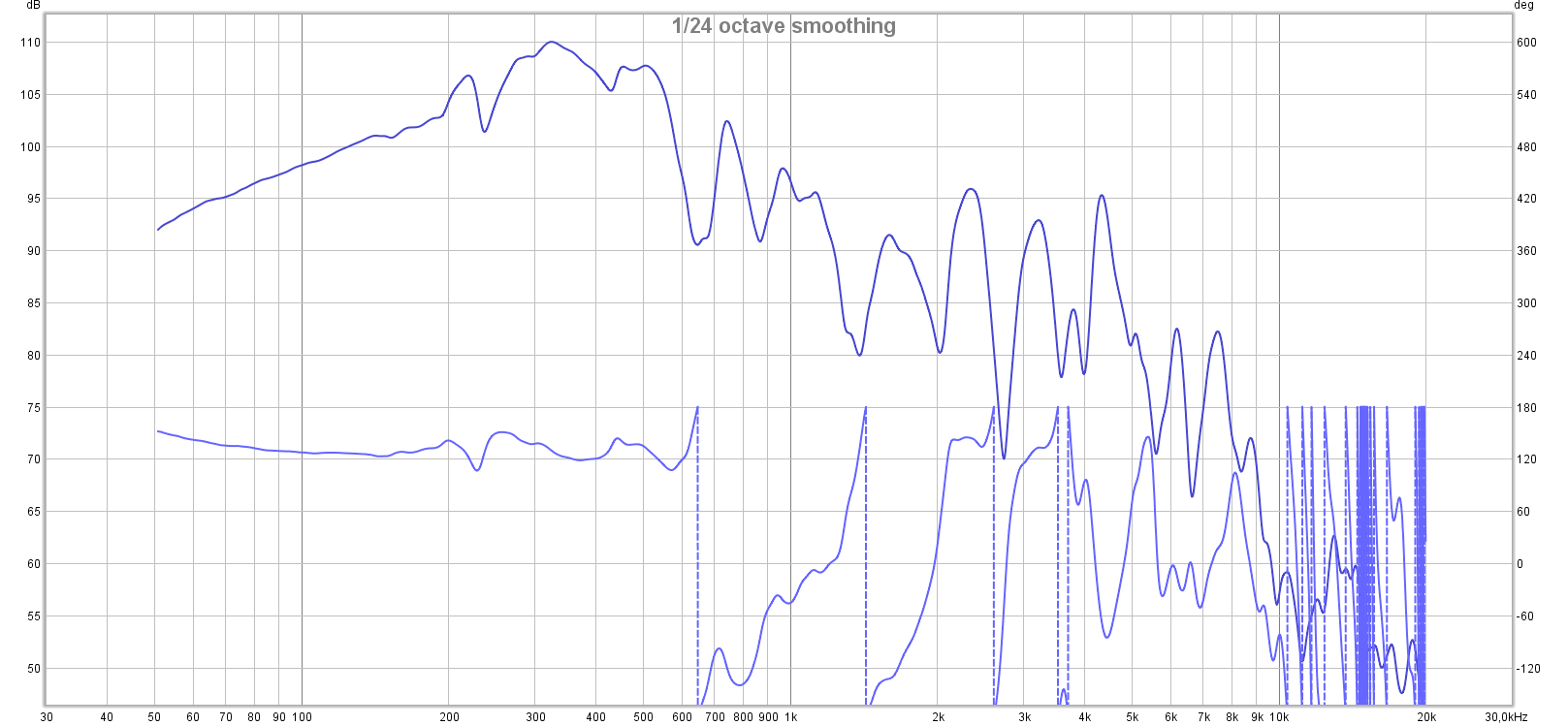
It rolls of from 600Hz+
Don't know yet what happens a little passed 200Hz but gonna wait and see when there is a back chamber.
Phase response looks good.
The there is the mid section:
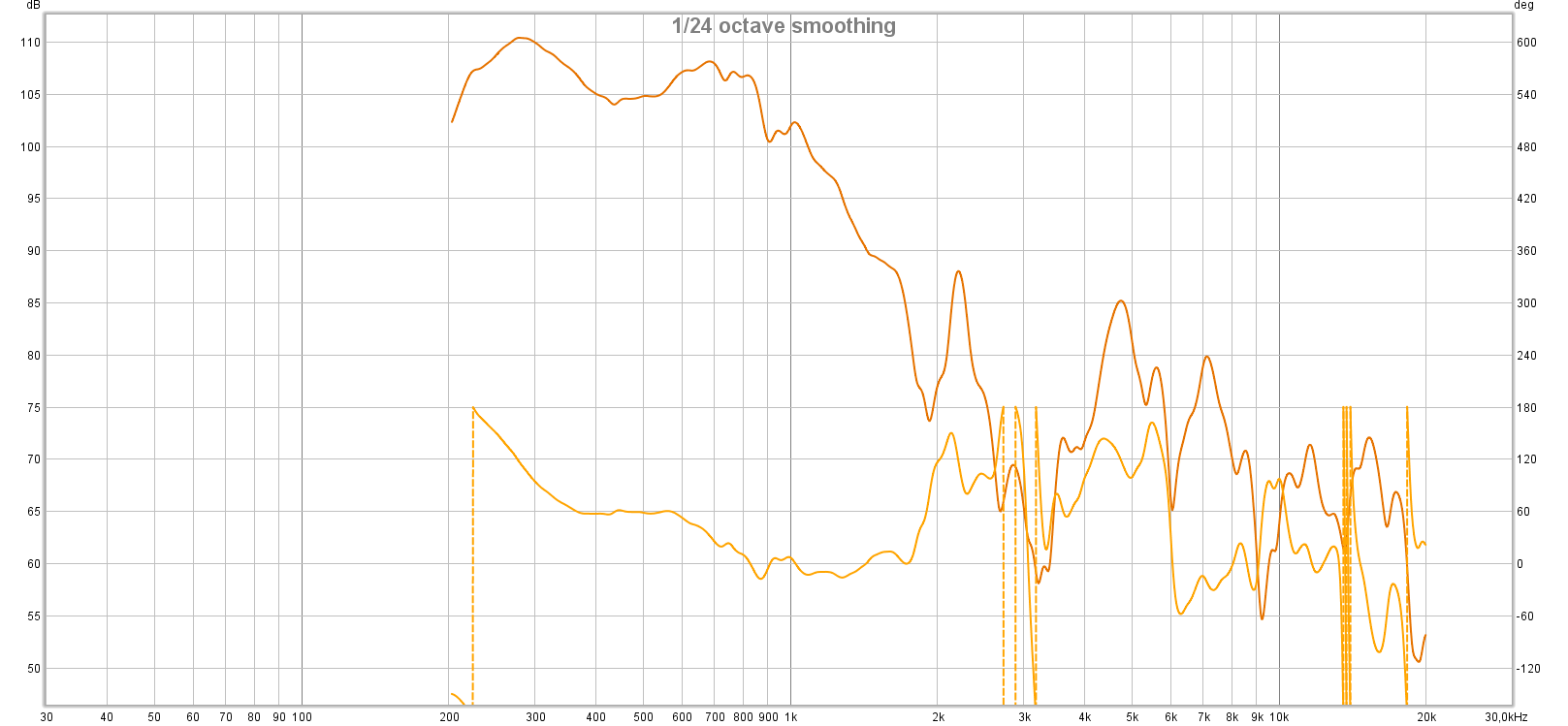
Not to bad. Those celestions work really great.
Gonna use them from 400Hz and up.
Phase looks ok and the sensitivity is about the same as the woofers wich makes the passive cross easier to design.
Then There is the hi section:
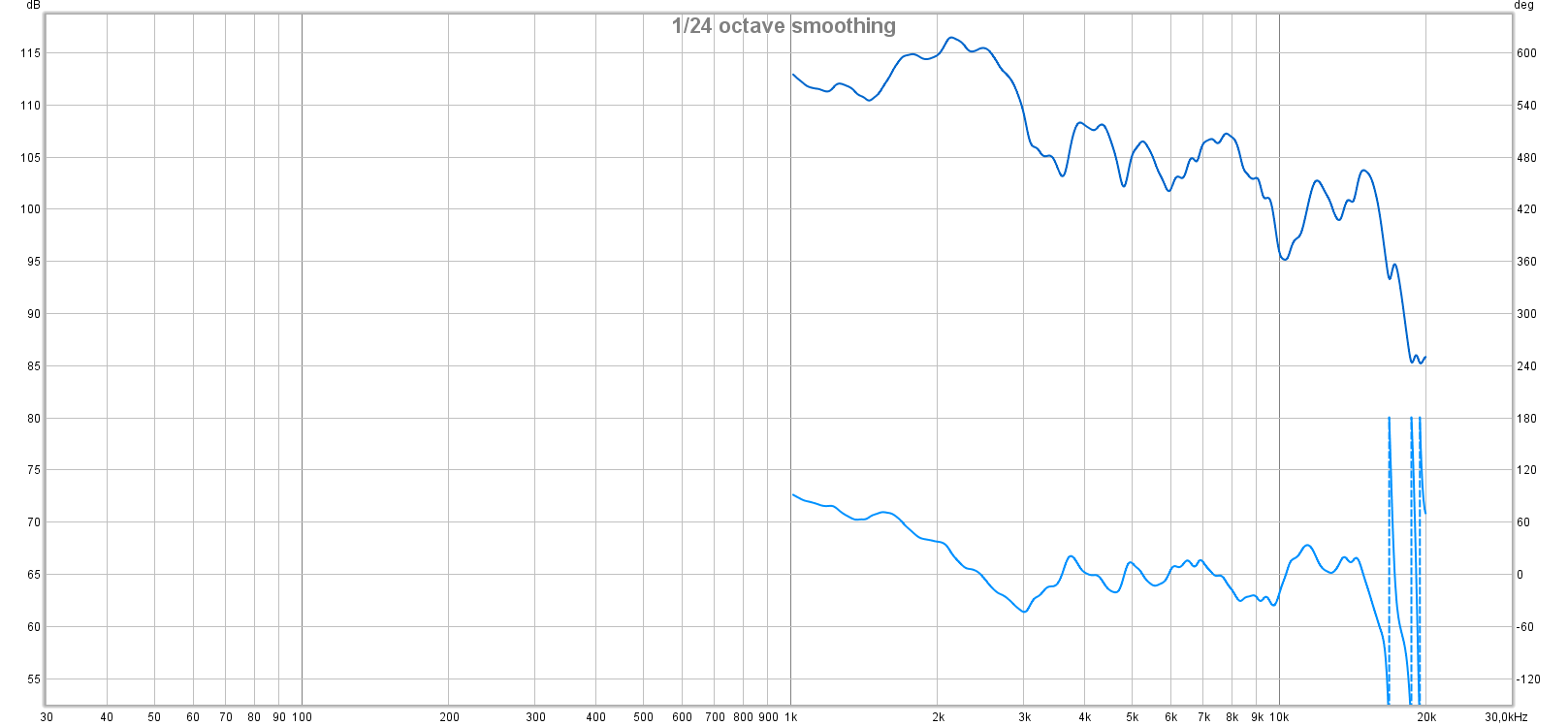
There is a bump around 2kHz that needs some attention. (I think it's also there in the datasheet of the CD10nd)
So I also measured the Impedances and exported everything To Xsim.
With some basic filters and a notch on the tweeter I've got this.

That doesn't look to bad I would think.
Still have to redo this when the back chamber and reflex ports are finished.
Maybe this could benefit from an alpass filter on the mid section.
This is the filter:
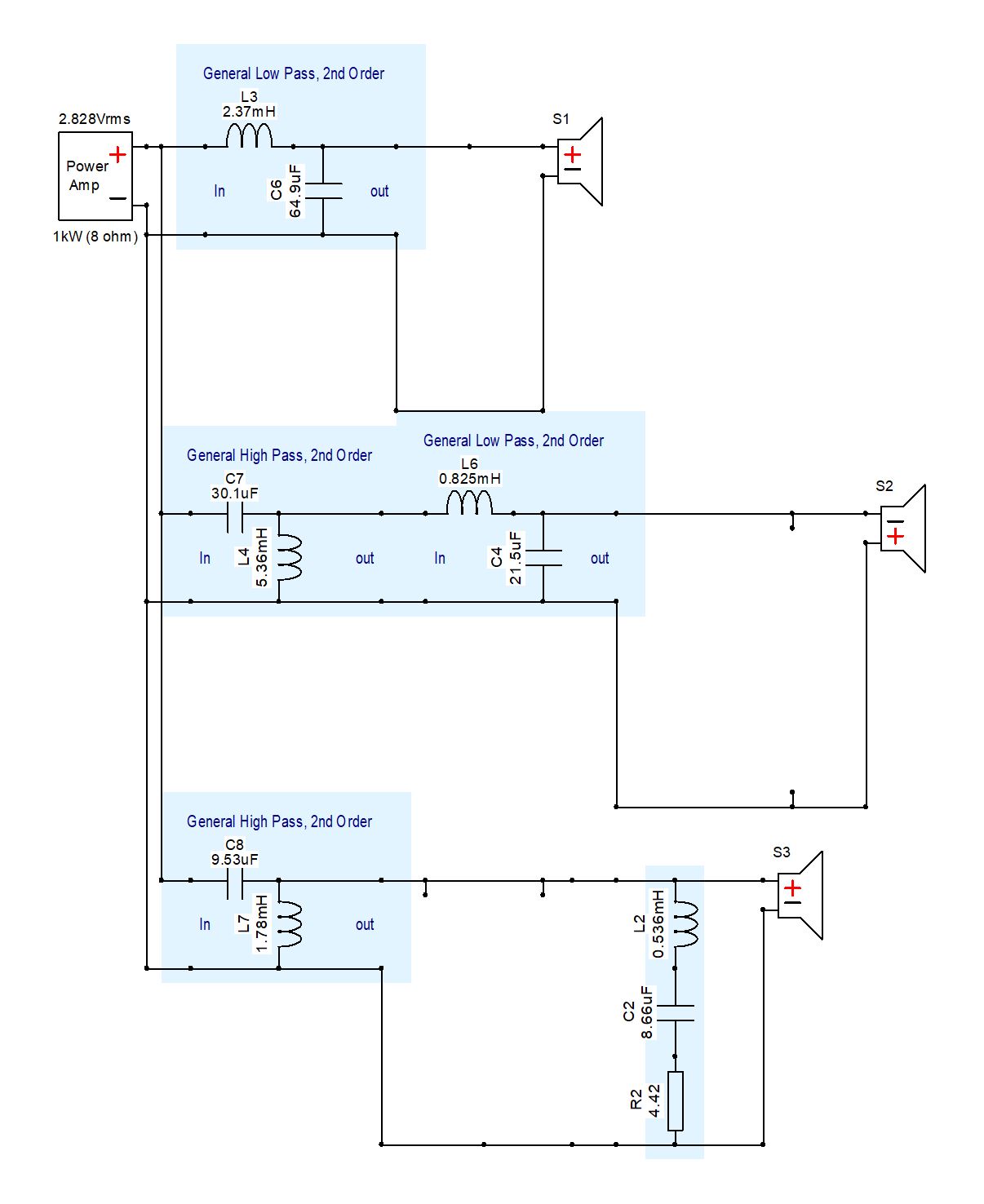
I also tried to use only a high pass on the mid section and no lo pass but then the impedance drops a little low.
This is the impedance:
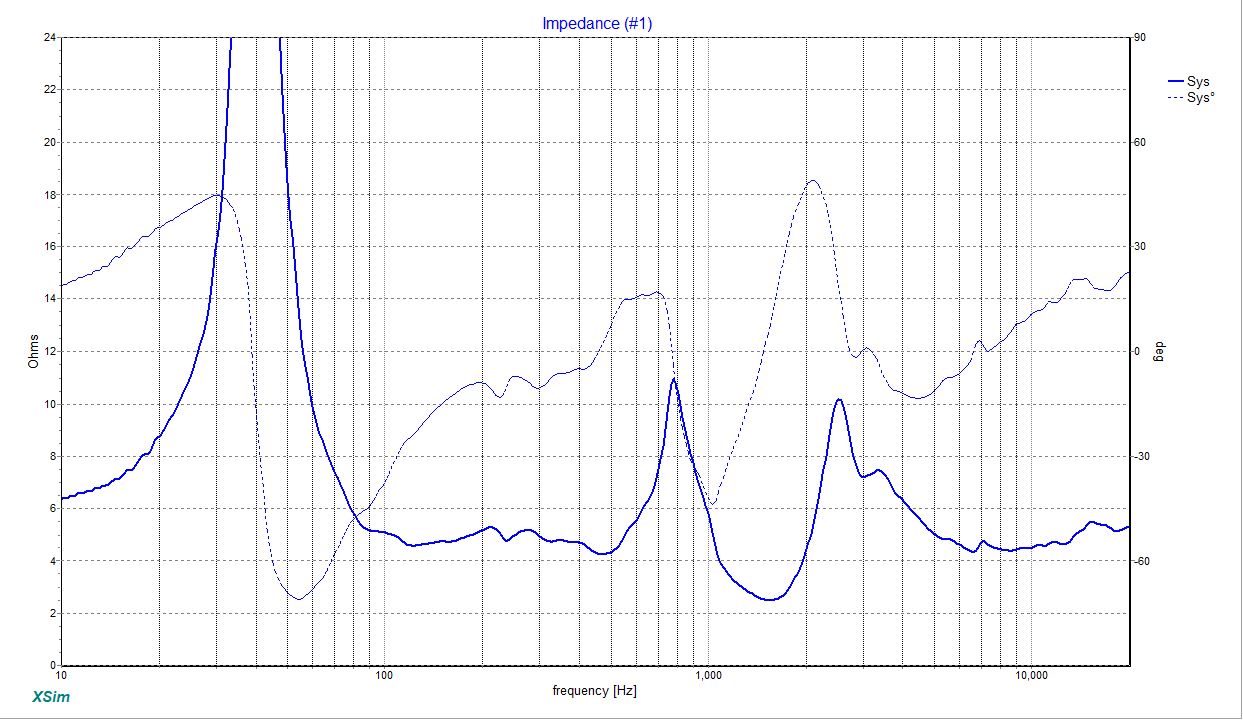
A little bit passed 1k it drops a little low.
For the ressed it looks ok but I would say it's more like a 4ohm speaker.
So next up will be building the back chamber and reflex ports, do some new measurements and design the final cross over.
When I first mounted them I made a rough test with some active crossover and I was quite amazed. It has a lot of detail.
The enclosure for the Woofers is not ready yet so they don't have a back chamber with reflex ports yet.
I boosted the lowend to get an idea of what it sounds with some bass.
Those Oberton 10b200 do a very nice job.
So some measurements.
The Low section:

It rolls of from 600Hz+
Don't know yet what happens a little passed 200Hz but gonna wait and see when there is a back chamber.
Phase response looks good.
The there is the mid section:

Not to bad. Those celestions work really great.
Gonna use them from 400Hz and up.
Phase looks ok and the sensitivity is about the same as the woofers wich makes the passive cross easier to design.
Then There is the hi section:

There is a bump around 2kHz that needs some attention. (I think it's also there in the datasheet of the CD10nd)
So I also measured the Impedances and exported everything To Xsim.
With some basic filters and a notch on the tweeter I've got this.

That doesn't look to bad I would think.
Still have to redo this when the back chamber and reflex ports are finished.
Maybe this could benefit from an alpass filter on the mid section.
This is the filter:

I also tried to use only a high pass on the mid section and no lo pass but then the impedance drops a little low.
This is the impedance:

A little bit passed 1k it drops a little low.
For the ressed it looks ok but I would say it's more like a 4ohm speaker.
So next up will be building the back chamber and reflex ports, do some new measurements and design the final cross over.
It has been a while, and I have finished the porting and box.
I took some measurements of the drivers. Weather was not good for outside so they are inside but it can give some clues.
Some pictures of the reflex ports and box.:
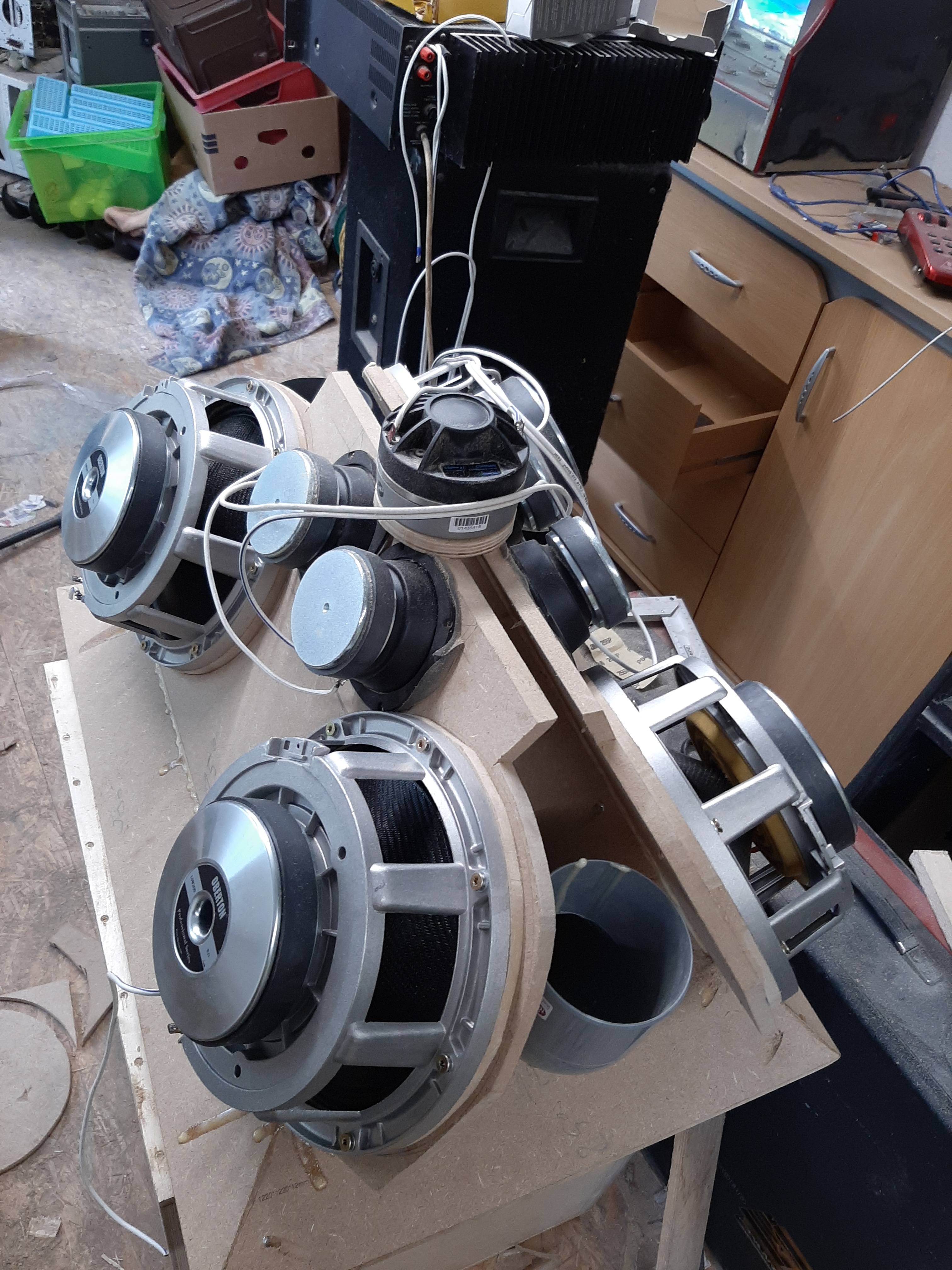
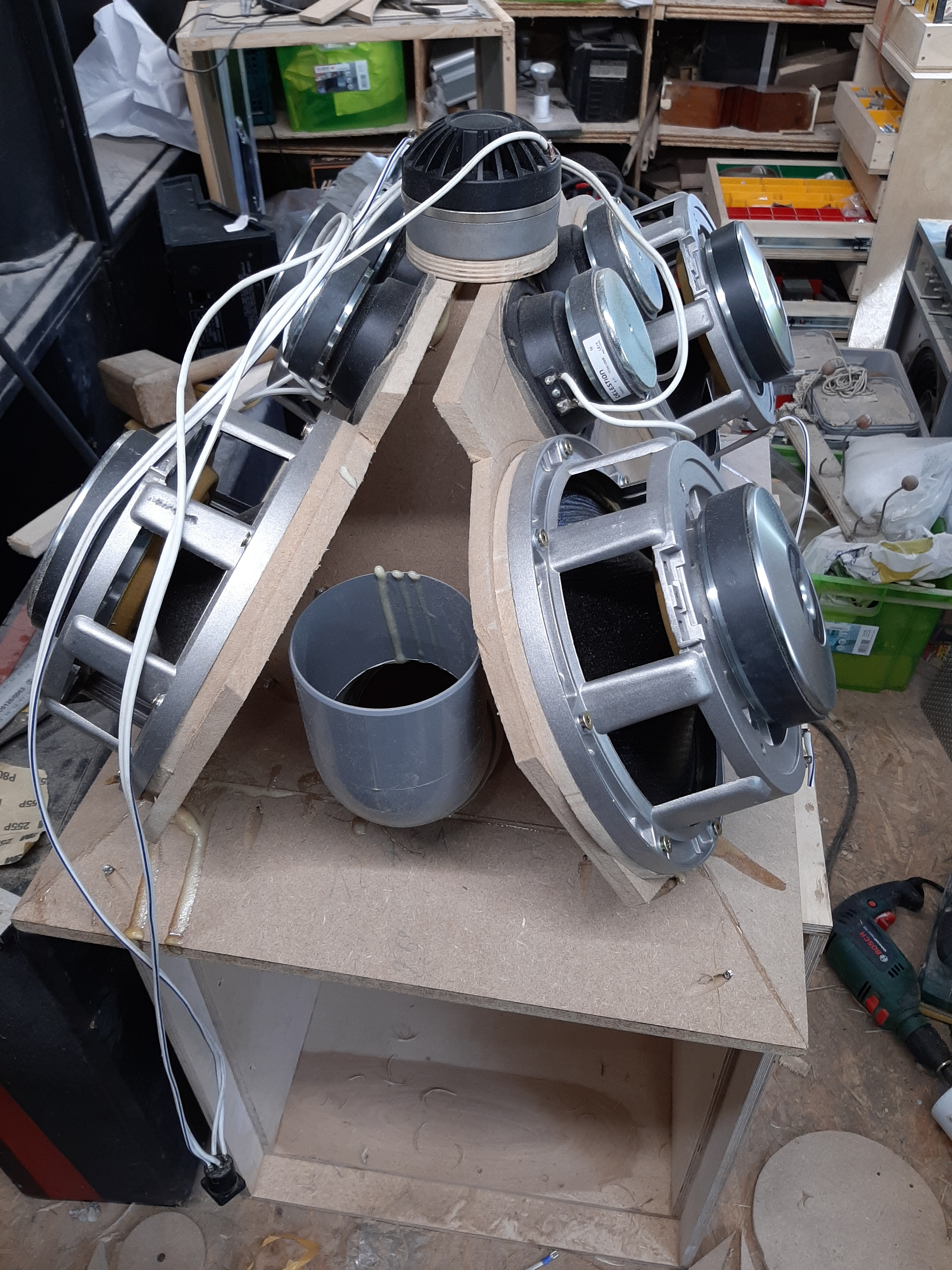
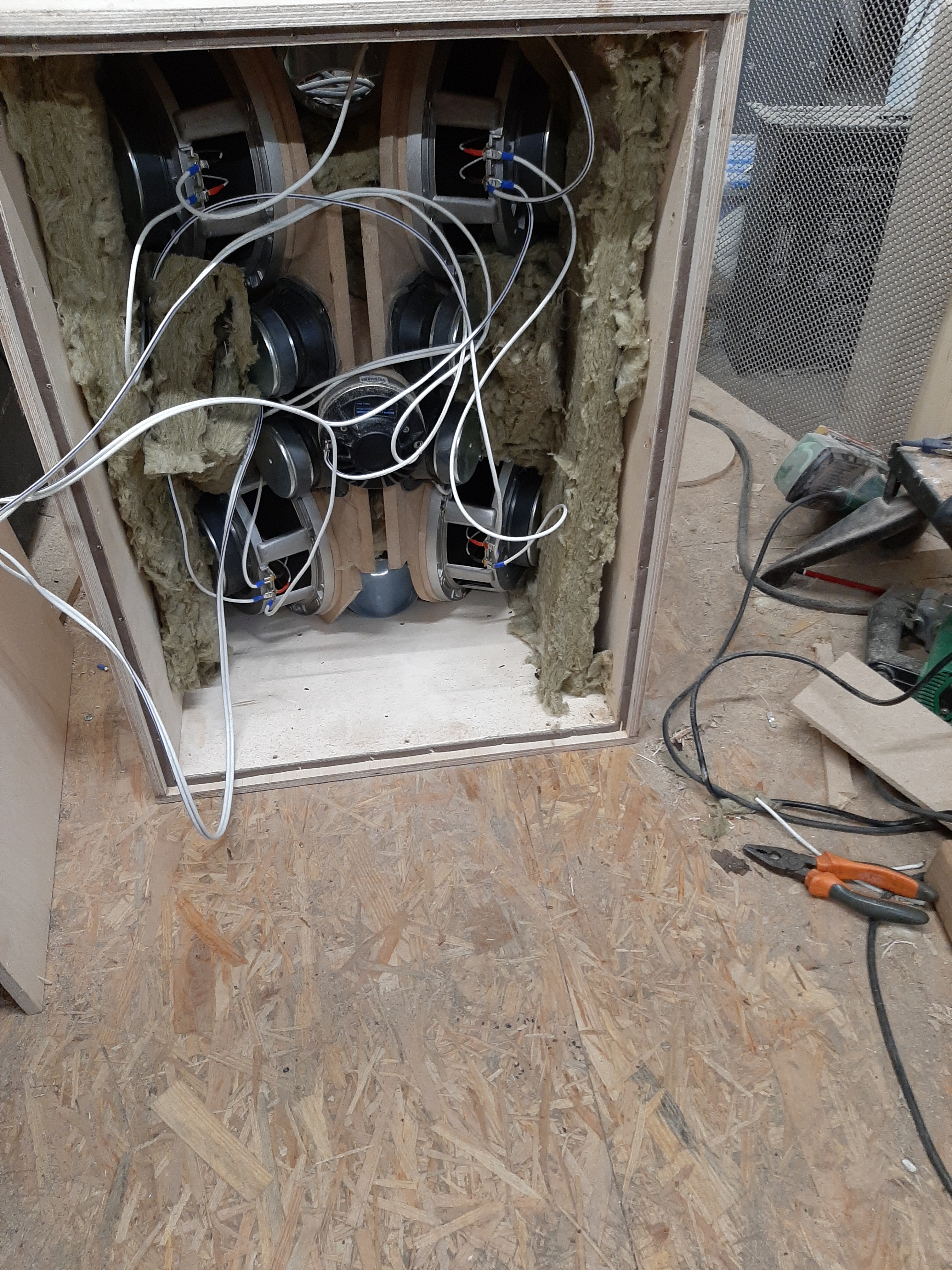
some measurements.
low:
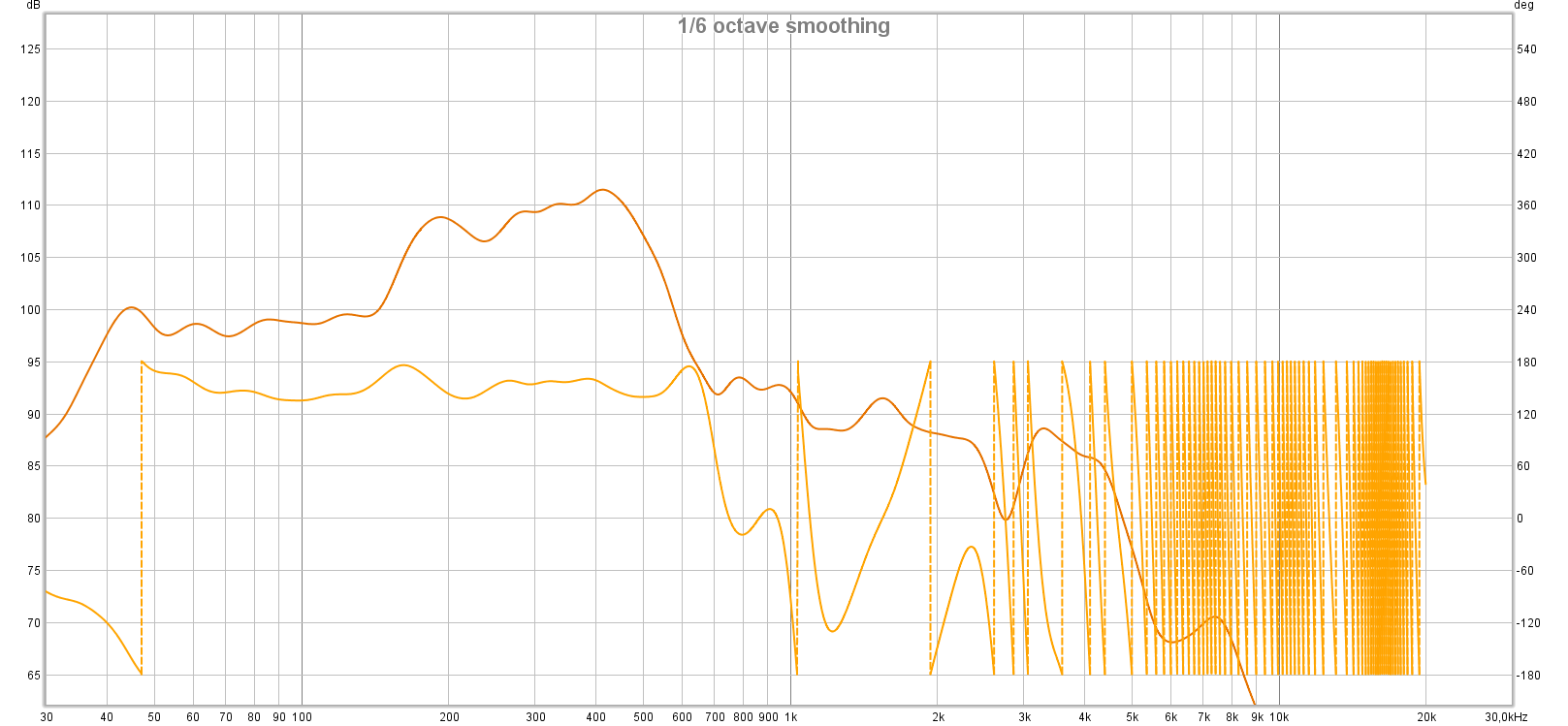
Mid:
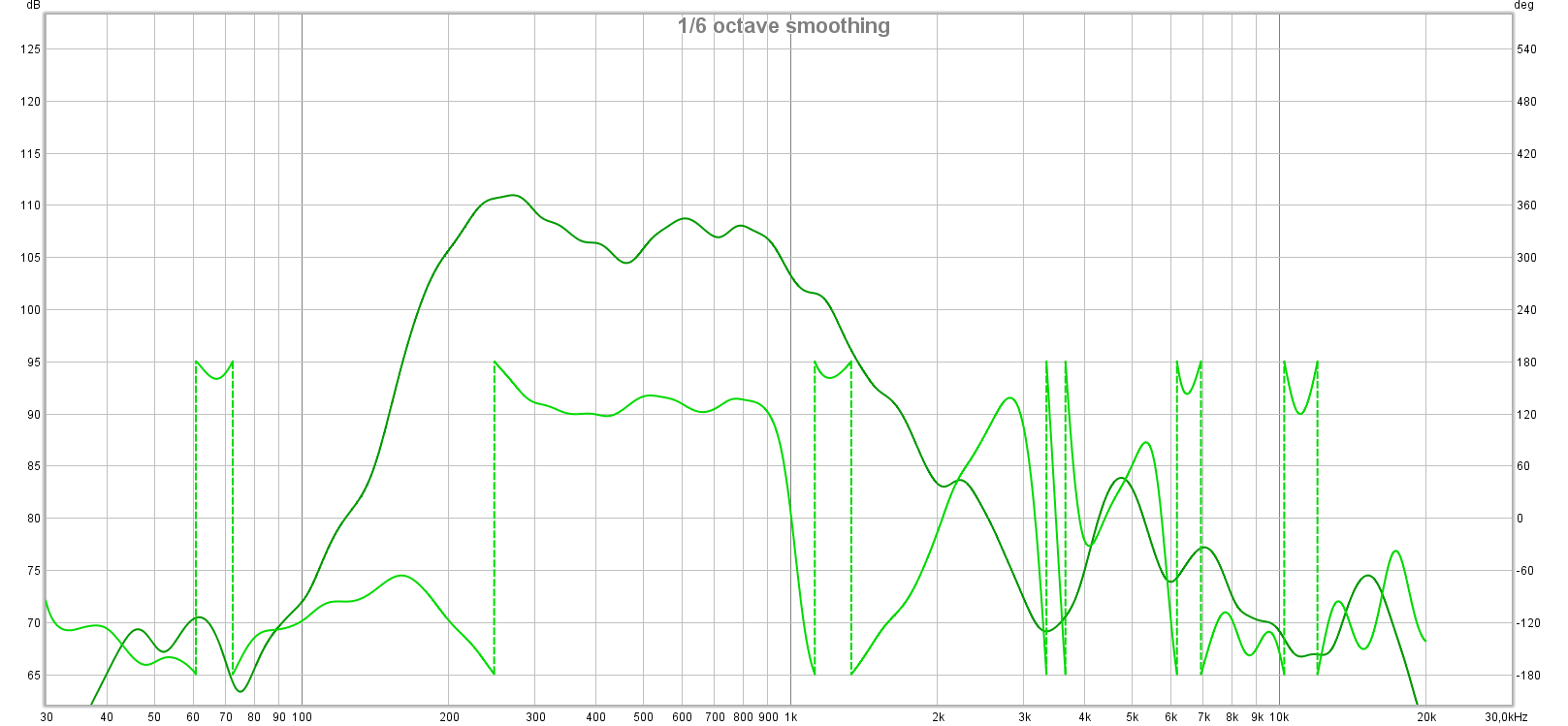
Hi:
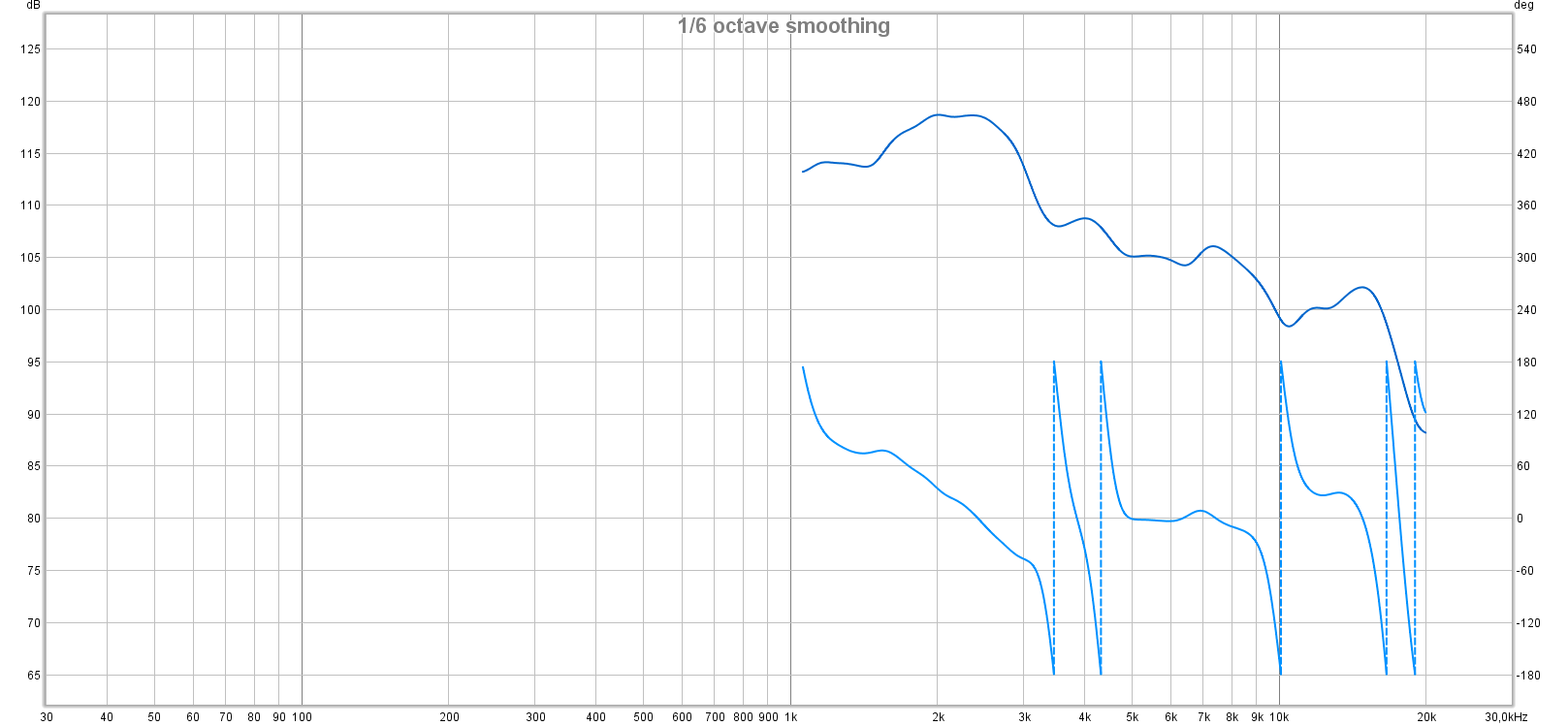
I also took the impedance of each section and loaded everything in Xsim (whoever made this program, it is really handy for getting a passive crossover like it should)
I came up with the following cross over:

The resistor in front of the tweeter filter was added, the cap of the tweeter filter was lowered from 4.5mH and the resistor in front of the midsection was changed to 84ohm (was 39ohm before)
These changes made a gentle roll of from low to Hi instead of going for flat. It sounds much nicer this way.
A predicted response from Xsim:
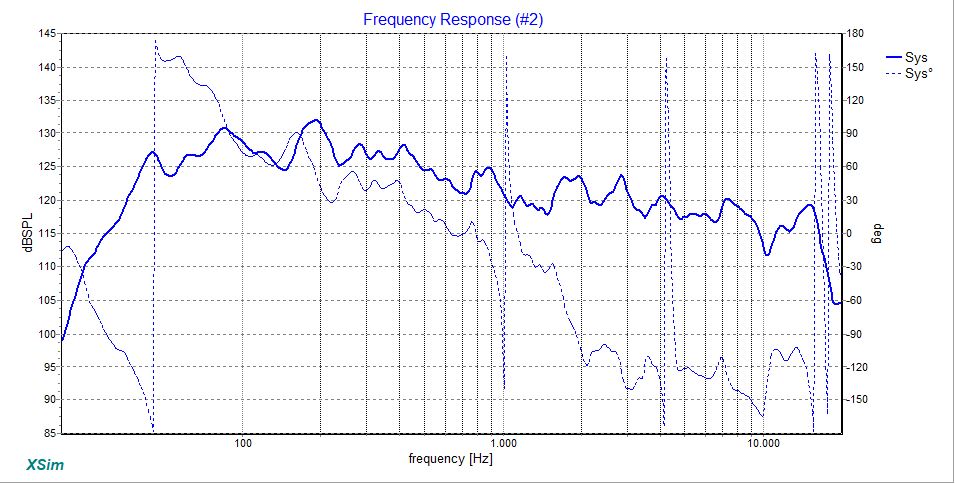
Don't really now what happened around 1k but in the real measurements this was gone.
Measurements:

and then the first version of the crossover measurement:
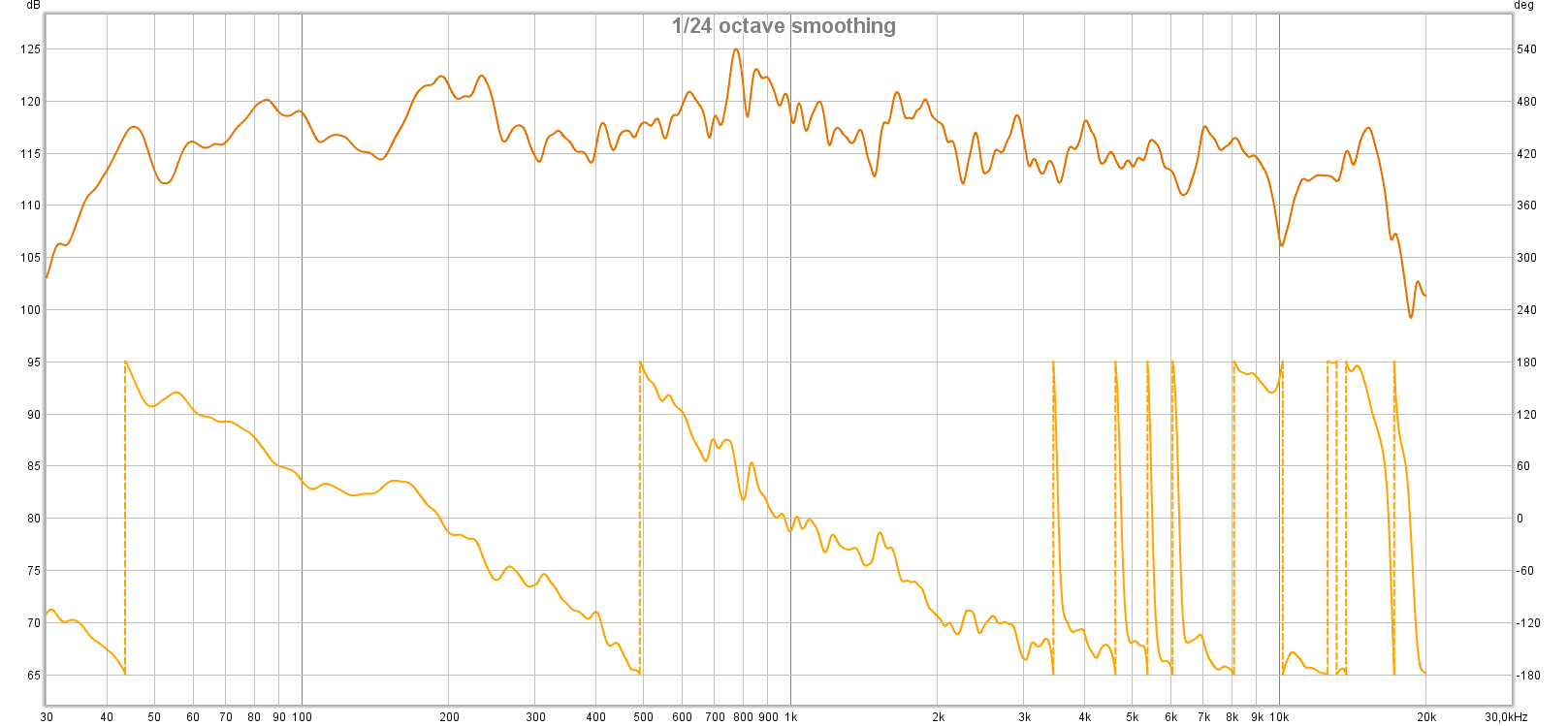
Some of the dips and peaks are from the inside reflections and I like the one that slightly rolls of from low to hi.
The sound is really nice. The details are incredible and this is only mono.
I was also amazed how low these obertons go.
The measurement mic was calibrated but it was closer then 1m from the speaker. More like 60cm. Still it goes loud enough for a good party.
One last picture of the cross-over:
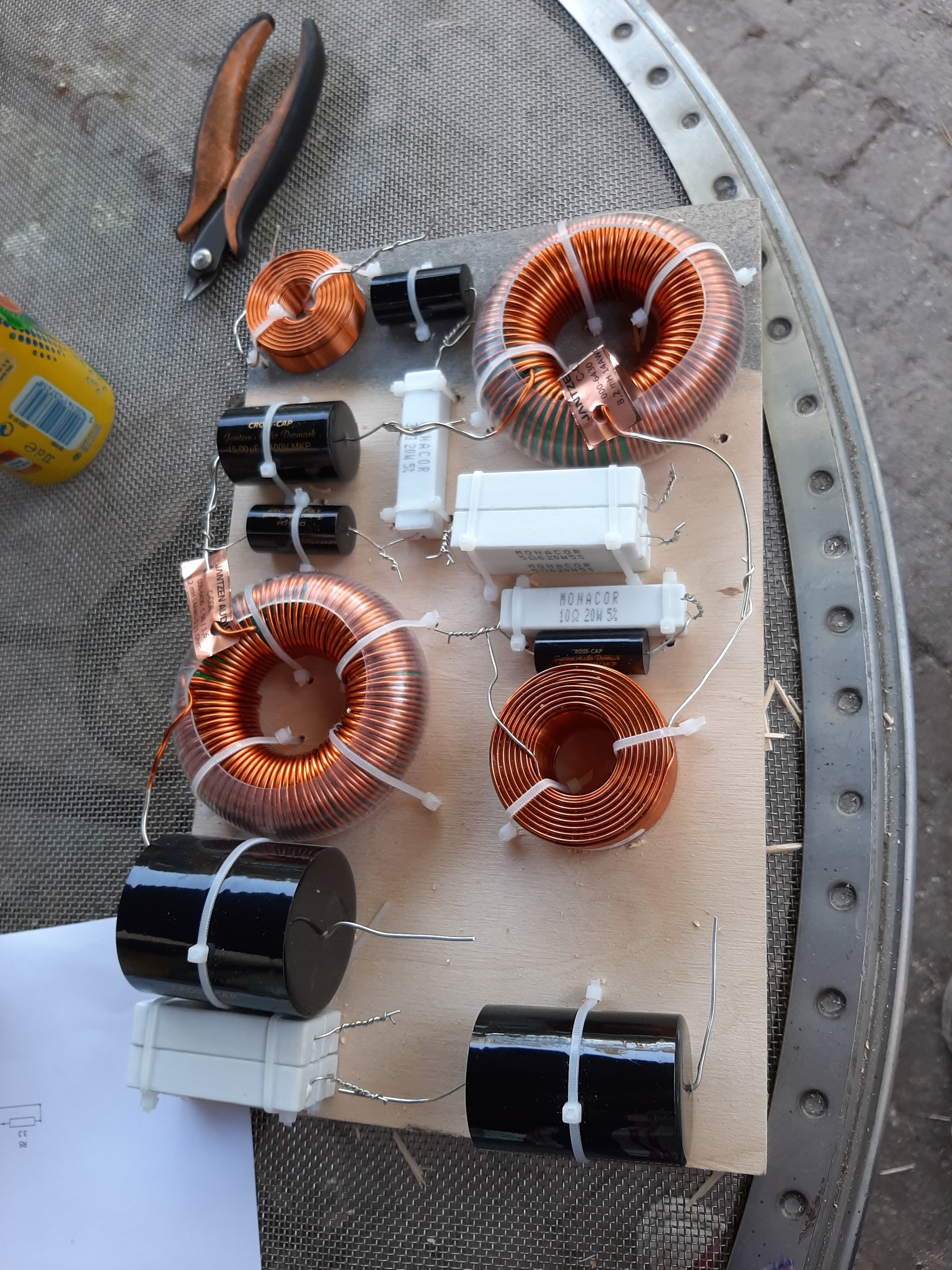
I took some measurements of the drivers. Weather was not good for outside so they are inside but it can give some clues.
Some pictures of the reflex ports and box.:



some measurements.
low:

Mid:

Hi:

I also took the impedance of each section and loaded everything in Xsim (whoever made this program, it is really handy for getting a passive crossover like it should)
I came up with the following cross over:

The resistor in front of the tweeter filter was added, the cap of the tweeter filter was lowered from 4.5mH and the resistor in front of the midsection was changed to 84ohm (was 39ohm before)
These changes made a gentle roll of from low to Hi instead of going for flat. It sounds much nicer this way.
A predicted response from Xsim:

Don't really now what happened around 1k but in the real measurements this was gone.
Measurements:

and then the first version of the crossover measurement:

Some of the dips and peaks are from the inside reflections and I like the one that slightly rolls of from low to hi.
The sound is really nice. The details are incredible and this is only mono.
I was also amazed how low these obertons go.
The measurement mic was calibrated but it was closer then 1m from the speaker. More like 60cm. Still it goes loud enough for a good party.
One last picture of the cross-over:

Very nice, i likey !
You should have some great low end.
Any idea what the finished box will weigh?
You should have some great low end.
Any idea what the finished box will weigh?
Well I have to say the lowend is great. Doesn't really need a subwoofer.
As you may have noticed I made everything kind of "heavy duty" crossover etc is also heavy duty you could say.
The box is on the heavy side. Something like 50-60kg I think.
I used 12mm birch ply but made 2 boxes that fit in each other. The inner box was made with less depth so the end of the horn can rest on the inner box.
Also the back of the box can easely be closed. you can see that in one of the pictures.
I used screws from the inside to put the 2 boxes together. This way there are not so many screws to cover on the outside before painting.
The actual thickness of the Bass reflex box is also 24mm.
On the front will be a grill and speakerfoam to cover everything.
For paint I was thinking about Warnex. I have seen a website that had these in a lot of different colors.
As you may have noticed I made everything kind of "heavy duty" crossover etc is also heavy duty you could say.
The box is on the heavy side. Something like 50-60kg I think.
I used 12mm birch ply but made 2 boxes that fit in each other. The inner box was made with less depth so the end of the horn can rest on the inner box.
Also the back of the box can easely be closed. you can see that in one of the pictures.
I used screws from the inside to put the 2 boxes together. This way there are not so many screws to cover on the outside before painting.
The actual thickness of the Bass reflex box is also 24mm.
On the front will be a grill and speakerfoam to cover everything.
For paint I was thinking about Warnex. I have seen a website that had these in a lot of different colors.
- Home
- Loudspeakers
- Multi-Way
- Midranges for synergy horn
